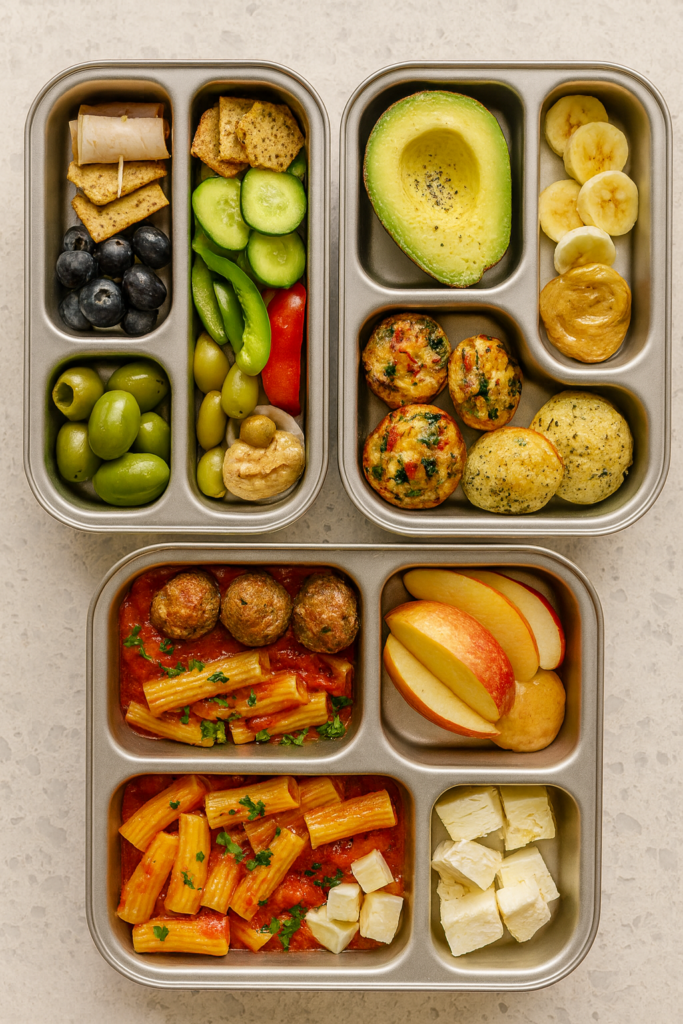
Packing healthy school lunch ideas for kids can feel like a daily puzzle—especially when you want something quick, balanced, and actually edible (because toddlers are ruthless critics). Trust me, I’m new to the game with a 14-month-old, so I’m figuring it out as I go, too. What’s helped me lately is aiming to make at least two to three recipes a week just for him—some for the fridge and some for the freezer so it lasts even longer. Having those ready-to-go options has been a major lifesaver!
The Back-to-School Lunch Dilemma
Even so, with the best intentions, it’s easy to fall back on the same familiar snacks just to get out the door. That’s why, with back-to-school season officially here, I wanted to put together a blog on healthy school lunches from toddlers to elementary school-goers because I know a lot of us are asking the same thing: What am I actually sending with my kid that will keep them fueled all day long?
Recently, I came across a school lunch online that made me pause—not in a judgmental way, but more like, “Okay, if I can help give you a few key ideas to make a lunch your kid will actually thrive on—something that supports focus, steady energy, and fullness throughout the day—then here we go!”
Here’s what that lunch in the video included: pasta from the night before (from a restaurant, without protein), three chocolate-covered pretzels, Pringles, a packaged granola bar, apple slices, and some mixed berries. Totally normal and totally relatable. However, nutritionally? It was mostly carbs and sugar, with almost no protein, fiber, or healthy fats to keep someone– let alone a tiny and highly mobile human– full, focused, and energized.
Of course, I don’t know the full context—maybe this kid was deep in a picky phase and this was all they’d reliably eat. In that case, you do what you need to do. But if you have a little flexibility, that’s where getting more intentional about what you’re packing can really start to make a difference. As a dietitian, I do my best to talk about and share recipes that are balanced with protein, fat, and fiber, which can help your kids stay more focused in class, feel more balanced emotionally, and avoid that post-lunch energy crash.
That’s why small tweaks can make a really big difference, without overhauling your entire routine. My goal is to help you feel confident packing lunches that fuel your kids’ bodies and brains because food absolutely plays a massive role in development, behavior, and how they feel throughout the day. Because I received tons of DMs asking how I would upgrade that lunch to a more healthy option, let me share all my thoughts + ideas below!
Healthy School Lunch Ideas for Kids: How to Upgrade a Deconstructed Lunchbox
Let’s use that real-life lunch example I shared above as a case study. The ingredients weren’t “wrong,” they just didn’t offer much in terms of staying power. But the good news is you don’t have to start from scratch. With a few simple swaps or add-ins, you can take a meal that’s mostly carbs and sugar and turn it into one that supports focus, balanced energy, and better moods throughout the day.
Here’s how I’d personally make it more nutrient-dense, one component at a time:
Pasta → Add Protein
Keep the pasta (no need to toss a food your kid already loves). Just pair it with a protein:
- A few mini beef or turkey meatballs (homemade or store-bought and freezer-friendly if you want to make a big batch and defrost a handful at a time). Try my Easy Italian Meatballs in Marinara I developed specifically for Hayes.
- Lentil or chickpea-based pasta for a naturally higher-protein option
- Shredded rotisserie chicken or cottage cheese mixed into the red sauce if you’re making it at home
Apple slices → Pair with Healthy Fats
Apples are a great lunchbox fruit—just round them out with a fat source to slow digestion. Also keep in mind that skin on fruit is fiber. Fiber = slowing down that blood sugar spike and supporting digestion, which is a win. So if you’re able to, keep the skin on apples for your littles.
- Add a scoop of peanut, almond, or sunflower butter (ingredients should be just nuts/seeds and salt)
- Bonus: sprinkle with cinnamon for extra flavor (and blood sugar support)
Chocolate-covered pretzels → Upgrade the Treat
You can still include a little sweet—but swap the ultra-processed options for ones with fewer additives and better ingredients:
- Simple Mills crackers + a small piece of dark chocolate (like Hu Kitchen Dark Chocolate Gems or Squares)
- A couple homemade bliss balls or energy bites (made with oats, dates, and nut butter), or an easy recipe like my PB Chocolate Chip Protein Bliss Balls.
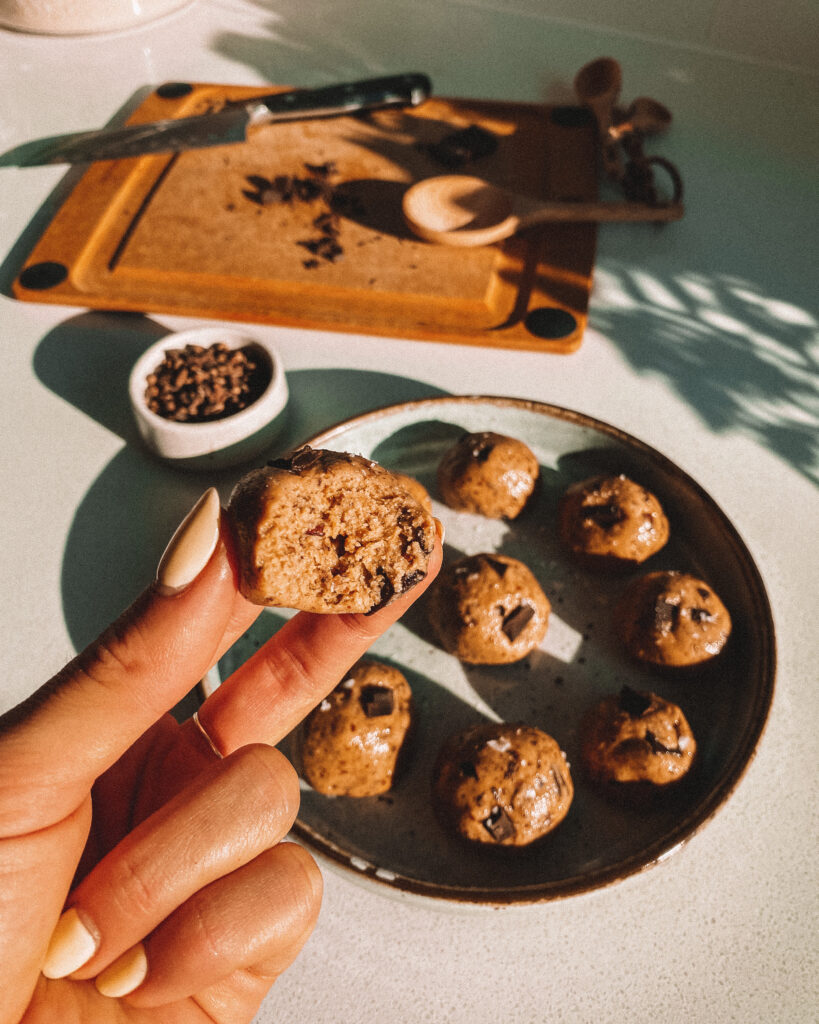
Pringles → Smarter Crunch
Craving that salty crunch? Try these better-for-you options:
- Lesser Evil grain-free puffs
- Bare Snacks dried fruit chips (with no added sugar)
- SeaSnax Organic Seaweed Sheets – roasted in olive oil, super low-ingredient and mineral-rich
- Ella’s Flats – these are SO good. Hayes loves them too. No additives, just nuts and seeds, so they’re high in fiber and protein. Linked here.
- Mary’s Gone Crackers (Original) – whole grain + seed-based, great for fiber
- Raw carrots, cucumbers, or jicama slices – add hummus or guac for a more nutrient-dense dipper
Packaged granola bar → Homemade Snack Bar
Most kid-friendly granola bars are more like candy bars in disguise. Instead, try:
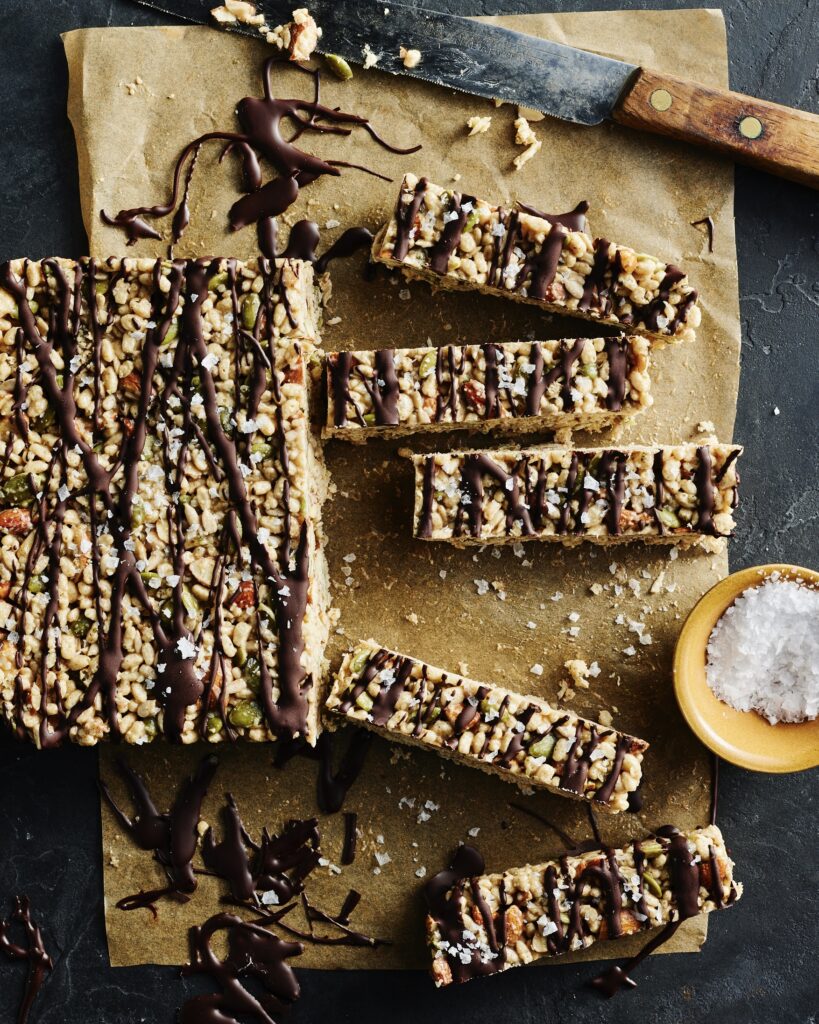
- My Chewy Snack Bars (from my cookbook)
- Or blend oats, nut butter, chia seeds, and a little honey or date paste into DIY bars or balls that freeze beautifully
The takeaway:
Keep the familiar structure, just think about how you can level it up with intentional swaps that are going to give you the most bang for your buck in terms of sustained energy + focus. Heavy carbs and lots of fruit don’t lend towards much lasting energy, plus your kids may feel hungry sooner after this type of meal. Alternatively, adding protein, healthy fats, and fiber can completely change the way a meal functions—turning a “filler” lunch into one that actually fuels.
Why This Combo Works: Fueling Focus, Behavior & Fullness with Every Bite
Of course we all want our kids to do well in school, but it’s not just about what happens in the classroom. What we pack in their lunchbox has a direct impact on their energy, ability to focus, mood, memory, and even how well they regulate their emotions. Food literally feeds the brain.
We’re all doing the best we can. But sometimes, even as parents, we need a little reminder (or a quick re-learn) about just how instrumental the ingredients we feed our kids are to their overall health. Their behavior, digestion, immune system, growth, development—it really all ties back to nutrition.
If your child is used to more processed foods or carb-heavy snacks, it can feel overwhelming to make changes. But it doesn’t need to be an all-or-nothing approach, and you definitely don’t need to flip your whole routine upside down. I truly believe in small, consistent habits adding up to transformative change over time.
Sometimes just understanding the why behind what we’re packing is all it takes to stay consistent—and actually feel good about what we’re sending our kids off with.
The Research:
- Protein improves academic performance: Higher protein intake is positively associated with better academic performance, including improved math scores. (BMC Public Health, 2021).
- Fat + fiber = focus & attention: Another study showed that 7–9-year-olds who ate meals higher in fiber and healthy fats performed better on attention and reaction time tasks (Pub Med, 2014).
- Balanced meals boost cognitive outcomes: Preschoolers who received nutrient-dense meals rich in whole foods and omega-3s showed improved working memory, processing speed, and learning capacity (Nutrients, 2022).
Even More Realistic Lunch Combos
Examples of lunches were the number one request from many of you moms on this topic, so I wanted to share a few more outside-the-box lunchbox combos to keep in rotation. Some are easy grab and go options and some include recipes to make ahead of time. Here are a few of my favorites that check the protein-fat-fiber boxes, come together fast, and taste yummy!
Mediterranean Bento Box
- Applegate roasted turkey or pasture-raised hard-boiled eggs
- Seed crackers (Simple Mills or Mary’s Gone Crackers)
- Sliced cucumbers + mini bell peppers
- Pitted olives of any variety
- Hummus (I love Hope brand [made with olive oil] or homemade)
- Fresh berries or sliced oranges
Breakfast-for-Lunch
- Meal Prep Egg Cups with chicken sausage and veggies
- Sliced avocado with sea salt + lemon
- Banana slices with almond butter
- Homemade oat bar or nutrient-dense muffin (frozen ahead for ease). Double Chocolate Zucchini Blender Muffins, GF Chocolate Banana Blender Muffins, Healthy Lemon Poppyseed Protein Muffins
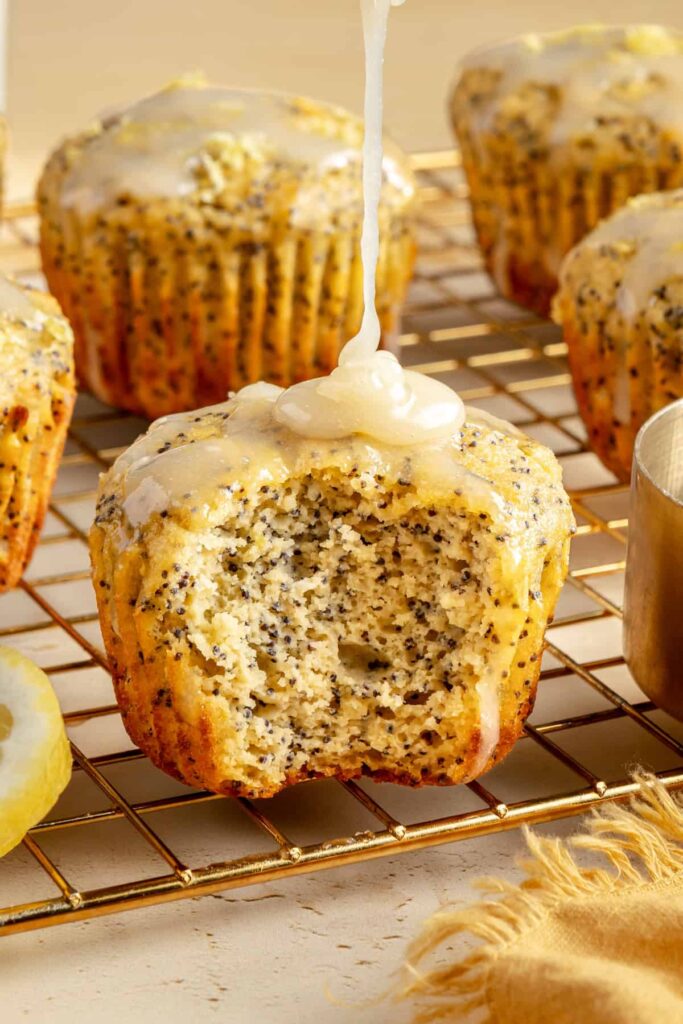
Easy Snack Plate
- Leftover grilled chicken, meatballs, Toddler Chicken Nuggets
- Any crunchy veg they love: carrot sticks, sugar snap peas, persian cucumbers, bell peppers
- Chia pudding or coconut yogurt with hemp hearts and nut/seed butter (ingredients should be only nuts/seeds and salt)
- A few Hu Kitchen Dark Chocolate Gems or Squares
Easy Wrap Kit
- Tortilla (corn, flour or Almond flour or cassava tortilla)
- Organic deli turkey, avocado slices, and microgreens
- Apple slices with peanut butter
- Lesser Evil Himalayan Pink Salt Veggie Sticks or popcorn with olive oil + sea salt
Mix-and-Match Mini Lunch Boxes
Let your kid build their own meal with small portions of 4–5 food groups. It’s customizable, low pressure, and actually more fun for picky eaters.
- Protein & Fat: Grilled chicken bites, organic turkey stick (Chomps, Applegate or Archer), or tuna/chicken salad with olive oil. For canned options, I personally like the brand, Wild Planet
- Whole Grain/Fiber: Simple Mills almond flour crackers, seed-based crackers (like Mary’s Gone Crackers), or brown rice cakes
- Veggies & Dip: Carrot sticks, cucumber rounds, or cherry tomatoes with hummus or guacamole
- Fruit: Apple slices with skin, mandarin wedges, grapes, or berries
- Treat: A dark chocolate square or homemade bliss balls
Warm Bento-Style Lunches (Perfect for Prep!)
If your kid prefers warm meals, try these nutrient-packed combos:
- Mini Taco Cups: Ground turkey, shredded cheese, guac, and chopped veggies inside Siete almond flour tortillas
- Veggie-Packed Pasta: Chickpea, lentil, or whole grain pasta with tomato sauce blended with cottage cheese (protein boost), roasted carrots, zucchini, or spinach
- Mini Egg Muffins: Scramble eggs with diced veggies and bake in a muffin tin—great for reheating during the week or grabbing 1 or 2 on the way to school for a quick breakfast!
Snack-Based Lunch (The Grazing Kid’s Dream)
For kids who don’t love a big sandwich or main dish:
- Protein: Hard-boiled egg, Greek yogurt (Stonyfield organic plain), cheese cubes, feta cheese (Hayes loves feta or any cheese really lol– I buy the Mt Vikos single serve packs), organic deli turkey rolls (pinned with toothpicks, or simply rolled up for toddlers)
- Crunch: Popcorn, roasted chickpeas, dry roasted nuts
- Fruit/Veggies: Snap peas, bell pepper strips, apple slices, kiwi halves, organic berries
For Picky Eaters If your kid is going through a picky phase:
- Use bento boxes to reduce pressure—smaller portions feel safer
- Always include one “safe food,” something they’re used to eating and they like!
- Let them help prep or choose 2-3 items from a chart so it’s more so their idea
- Repeat exposure: just because they refused it last week doesn’t mean they’ll refuse it forever
- Use cookie cutters, fun shapes, or lunch picks to make meals more fun
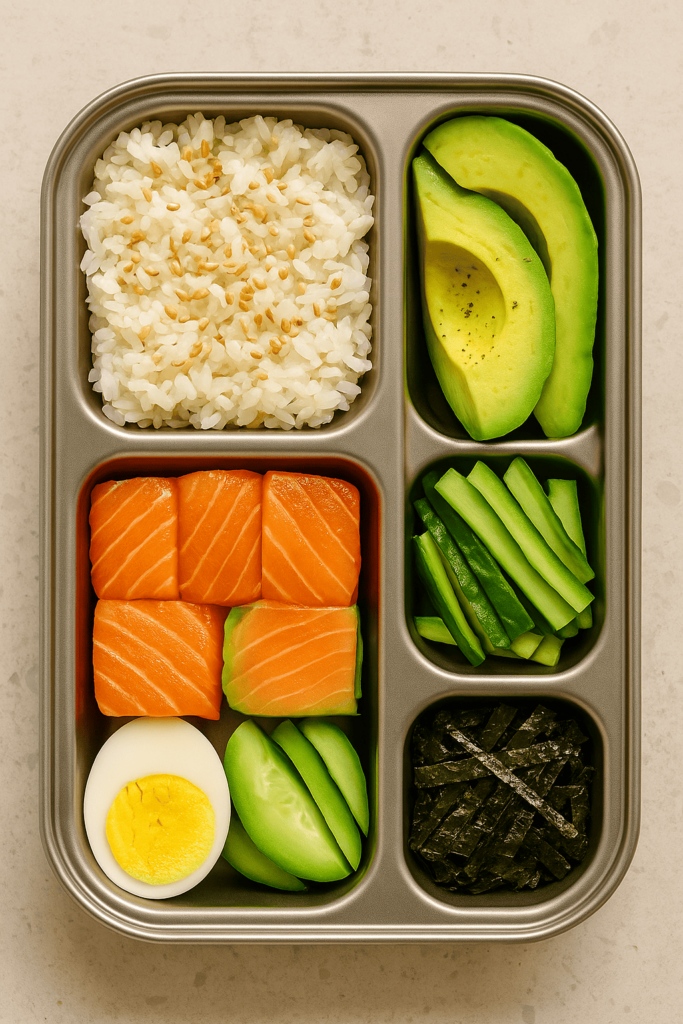
Additional Ideas to try out with your kids:
- Deconstructed sushi bowls (rice, avocado, salmon, cucumber, nori)
- Pita pizza rounds (GF pita + sauce + veggies + cheese)
- Mini breakfast tacos (eggs, beans, cheese in mini corn tortillas)
- Skewer sticks (mozzarella, fresh basil, tomato, turkey folded into ribbons), or some variation of this with foods they love, i.e. olives, cheese, tomatoes.
Key Takeaways for the Lunch-Packing Parent
- Keep it simple: prioritize protein, healthy fats, and fiber.
- You don’t need to reinvent the wheel—just upgrade what you’re already packing.
- Pack color + texture variety when possible—it increases nutrient exposure and keeps kids interested.
- Skip the ultra-processed snack packs and look for brands with minimal, whole-food ingredients (if you don’t recognize something on the label, your kid’s body probably doesn’t either).
- Utilize leftovers as best you can (and if your littles approve!). This is a major time saver.
- If you have one or two days a week with a few hours of free time, plan ahead and prep 1-3 recipes. If you can, double the batch and freeze leftovers to pull out a few days or a week later for an even bigger time saver.
- And above all: progress > perfection. You don’t have to be 100% “clean” to make a big difference. All that matters is that you become more aware of how your littles function with the food they’re given. Well, same for you too! It truly makes a difference when we consume whole foods versus processed packaged items, which can leave us feeling hungry and depleted soon after. Make it a habit to focus on protein, fat and fiber and your family will thrive with more nutrient-dense options!
I hope this post was helpful to any parents planning school lunches, or even just meals in general. If you want a look into the daily meals I’ve been feeding Hayes, check out my TODDLER FOOD highlight on my Instagram feed for more ideas. If you still have questions or feedback after this post, please let me know in the comments below 🙂

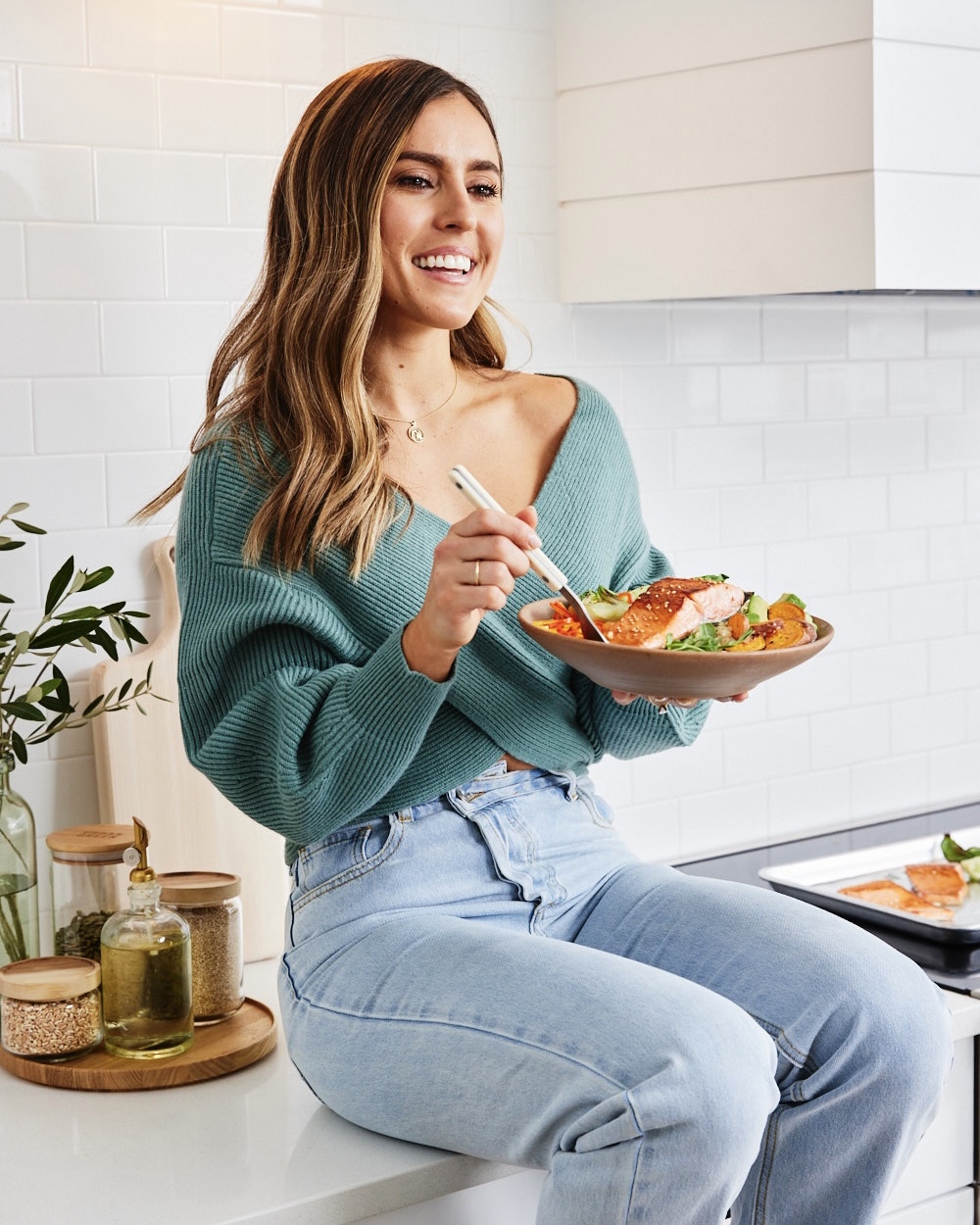

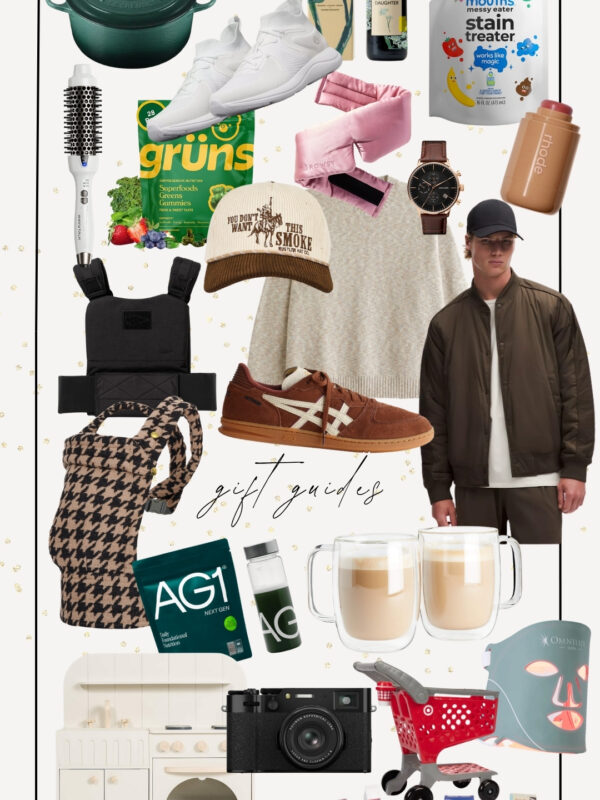










Comments